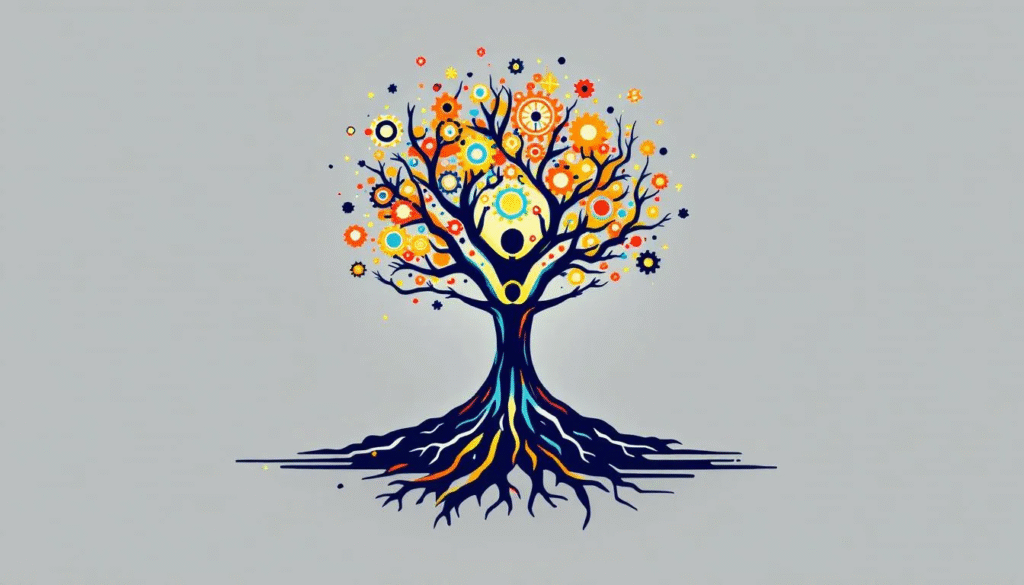Mindset Growth: Strategies for Personal and Professional Success
Have you ever looked back at a tough situation and realized it taught you more than any easy win ever could? That’s the power of mindset growth in action. Whether you’re facing a career setback, struggling with a new skill, or simply trying to break out of your comfort zone, how you view challenges can make all the difference.
In this article, we’ll dive into strategies that can help you develop a growth mindset, transforming the way you approach obstacles and opening doors to personal and professional success.
“When I failed my first university exam, I was devastated,” recalls Maya, now a successful software engineer. “But that moment pushed me to rethink my learning strategies. Instead of seeing it as a sign of low ability, I treated it as just the starting point.”
Key Takeaways
- Embrace challenges and see them as valuable learning opportunities to build resilience and unlock personal growth.
- Focus on effort and the learning process rather than relying on natural talent—this shift fuels continuous improvement.
- Foster a growth mindset at school or work to drive innovation, stronger collaboration, and long-term success.
Understanding Mindset Growth

At its core, the growth mindset is built on the belief that our intelligence, skills, and abilities are not fixed, but can be developed through consistent effort, meaningful learning, and targeted practice. Unlike a fixed mindset, which assumes our basic qualities are unchangeable, a growth mindset encourages us to see challenges not as threats, but as essential parts of the learning process.
People with a growth mindset understand that every obstacle is a chance to grow. Their belief in continuous improvement fuels their motivation to push past failures and keep building new skills. Instead of staying within the comfort zone, they stretch themselves—often discovering strengths they didn’t know they had.
“When I started learning to code at 35, I constantly failed,” says Ben, now a web developer. “But every error message became part of the process. That’s when I stopped seeing my ability as fixed—and started believing in development.”
The distinction between the two mindsets—fixed and growth—was made famous by Carol Dweck, whose research on human motivation changed how we understand success. In her theory, those with a fixed mindset tend to avoid constructive feedback, fear mistakes, and often give up when faced with obstacles. In contrast, individuals with a growth mindset approach see effort as the path to mastery.
In Mindset: The New Psychology of Success, Dweck writes that our beliefs about our own potential directly shape our future. Through repeated learning opportunities, our brains adapt and improve—a concept now widely accepted in neuroscience.
Adopting a growth mindset transforms how we approach both personal and professional life. It leads to greater resilience, deeper knowledge, and sustained progress. Instead of being limited by fear of failure, we become energized by the process of growth itself.
Fixed vs. Growth Mindset: Key Differences
Understanding the fundamental differences between growth and fixed mindsets is crucial to adopting a growth mindset. These two ways of thinking represent distinct perspectives on intelligence, ability, and the role of effort in building skills. A fixed mindset is rooted in the belief that abilities are innate and unchangeable. Individuals with this mindset often perceive their intelligence and talents as fixed, leading them to avoid challenges, resist constructive feedback, and believe that hard work is useless. Over time, this limits their personal development and reduces their capacity for growth.
In contrast, a growth mindset is grounded in the belief that abilities can be developed through consistent effort, effective learning strategies, and a willingness to confront challenges. The way individuals respond to a challenge is often shaped by whether they operate from a fixed or growth mindset. Those with a growth mindset view challenges as meaningful learning opportunities, rather than threats to their self-esteem. This mindset encourages a positive response to mistakes, values constructive feedback, and supports a resilient and adaptable approach to life’s obstacles.
The real difference between growth and fixed mindsets isn’t about talent—it’s about how we react when things get difficult.
The Benefits of Adopting a Growth Mindset

Adopting a growth mindset can truly transform your life—not just in theory, but in real, practical ways. One of the most important benefits is the development of resilience in the face of setbacks. People with a growth mindset don’t fear challenges; they embrace them. Even during the most challenging times, they rely on effort, learning, and persistence to move forward.
A growth mindset helps individuals view failures not as dead ends, but as powerful learning opportunities. Each mistake becomes a stepping stone toward growth and improvement. This mindset leads to stronger mental flexibility, deeper self-awareness, and the ability to adapt in a constantly changing world.
“When my startup failed, I thought I had lost everything,” says Elena, now a successful business owner. “But with a growth mindset, I turned every failure into a learning experience—and it made all the difference.”
In the professional world, adopting a growth mindset approach fuels a culture of continuous development. Employees in growth-focused environments are more likely to develop new skills, seek out constructive feedback, and engage in meaningful learning strategies. They aren’t afraid to take on new challenges because they understand that real success comes from persistence and experimentation—not perfection.
Organizations that promote a growth mindset see higher employee engagement, more creativity, and better long-term performance. Encouraging lifelong learning boosts job satisfaction, fosters innovation, and prepares teams to face future obstacles with confidence.
On a personal level, a growth mindset supports the pursuit of new knowledge and drives individuals to set goals, take risks, and stay open to improvement. Whether you’re learning a new language, launching a business, or simply working on personal habits, this mindset gives you the belief that development is always possible.
The most powerful thing about a growth mindset is that it puts your future back in your hands.
By embracing a growth mindset, you’re choosing to grow, evolve, and succeed—one challenge, one failure, and one step at a time.
Practical Strategies to Foster a Growth Mindset

Now that we understand the benefits of a growth mindset, let’s explore practical strategies to cultivate mindset growth in everyday life. One of the most effective ways to start developing a growth mindset is by actively embracing challenges. People who adopt this mindset are more willing to step out of their comfort zone, confront obstacles, and persist even during challenging times. They don’t view setbacks as failures, but as valuable learning opportunities that contribute to their personal development.
A second core strategy is to focus on effort over talent. Replacing the belief in “natural ability” with an emphasis on hard work, consistency, and the learning process helps reinforce a growth mindset approach. This shift empowers individuals to appreciate the importance of practice, resilience, and daily improvement—key ingredients in developing new skills.
“When I stopped saying ‘I’m not a creative person’ and just started designing every day, things changed,” says Amira, a freelance illustrator. “I realized that progress came from effort and learning, not talent.”
Another helpful tactic is to use specific learning strategies that support memory, comprehension, and performance—such as summarizing notes, using visual aids, or applying spaced repetition. These tools help individuals develop more effective habits and build confidence through consistent practice.
Learning from mistakes and failures is also essential. People with a growth mindset recognize that errors are part of the learning process, not signs of inadequacy. Reframing setbacks as chances to grow builds resilience and strengthens the ability to handle challenges constructively.
Finally, don’t shy away from constructive criticism. Seeking out constructive feedback from teachers, mentors, or peers helps clarify blind spots and uncover new ways to improve. This feedback becomes fuel for growth rather than a reason to retreat.
By applying these strategies consistently, anyone can begin developing a growth mindset that supports continuous growth, deeper learning, and greater success—personally, academically, and professionally.
Embrace Challenges as Learning Opportunities
Individuals with a growth mindset consistently embrace challenges, seeing them not as threats, but as valuable learning opportunities. This positive mindset encourages people to move beyond their comfort zone, explore new things, and face difficulties with curiosity rather than fear. Viewing challenges as chances to grow leads to deeper learning, more developed skills, and ultimately, greater success.
When people treat setbacks as part of the learning process, they build lasting resilience. They understand that effort, not talent alone, drives improvement. Whether it’s learning a new language, speaking in public, or managing a difficult project, embracing struggle leads to long-term personal and professional development.
“The first time I gave a presentation, my hands were shaking,” says Tom, a project manager. “But I kept practicing. Each time I stepped out of my comfort zone, I felt a bit more capable. Over time, I built greater confidence and now I speak to large teams with ease.”
A great way to begin embracing challenges—especially during challenging times—is to start small. Take on manageable tasks that stretch your abilities slightly beyond your current limits. Gradually increase the difficulty as your skills develop. This consistent practice leads to better problem-solving, stronger habits, and improved adaptability when facing real obstacles.
By actively seeking out learning opportunities and embracing new challenges, you strengthen your growth mindset, reinforce your belief in self-development, and position yourself for lasting growth in all areas of life.
Focus on Effort Over Talent
Valuing effort over natural talent is a key principle of the growth mindset. Individuals who adopt this mindset understand that hard work, dedication, and the learning process are far more important for long-term success than simply having innate ability. By focusing on effort, people build resilience, stay committed during challenges, and develop the skills needed to reach their full potential.
Celebrating effort encourages a deep love for learning and promotes continuous improvement. Instead of only rewarding final outcomes, individuals and educators should emphasize the value of practice, persistence, and progress. This shift helps reinforce positive behaviors and supports mindset growth in the long run.
“In my classroom,” says Ms. Hernandez, a high school teacher, “we reward process, not just results. I give more praise for consistent effort than for getting everything right the first time. That’s how real learning happens.”
Techniques for highlighting effort include providing constructive feedback that focuses on the steps taken, not just the outcome. Recognizing small wins—like learning a new concept or trying a new strategy—helps reinforce motivation. These habits strengthen the growth mindset approach, fostering adaptability, resilience, and steady personal development.
By consistently focusing on effort over talent, we create an environment where growth, confidence, and lifelong learning can thrive.
Learn from Mistakes and Failures
A growth mindset encourages seeing failure as a chance to learn rather than a reflection of one’s abilities. Viewing mistakes as opportunities for development is crucial for fostering a growth mindset. Reflecting on what has been learned from mistakes is a key part of personal growth, as it allows individuals to gain valuable insights and skills through perseverance. By embracing this perspective, individuals can navigate through obstacles more effectively and continue to grow and improve.
Establishing realistic and measurable goals can guide individuals through barriers and help them stay focused on their long run objectives. Developing a clear, structured plan is essential for overcoming challenges and maintaining human motivation, ultimately leading to greater success and personal growth; this is just the starting point to set goals and succeed in reality, ensuring a brighter future. Behavior is a key factor in this process.
Cultivating a Growth Mindset in Educational Settings

Promoting a growth mindset in educational environments involves more than just encouragement—it requires intentional strategies that emphasize effort, persistence, and the value of the learning process. Effective growth mindset strategies include normalizing struggle, framing challenges positively, and creating a safe space where students feel supported as they make mistakes and grow.
Teaching students that skills—even in subjects like math—are not fixed traits, but can be developed through practice, hard work, and learning opportunities helps dismantle the “math person” myth. Everyone can improve with time, effort, and the right guidance.
“There’s no such thing as someone who’s just not smart enough—only someone who hasn’t been shown how to develop their abilities yet,” says Mr. Carter, a 7th-grade teacher who uses growth mindset language daily in his classroom.
Resources such as Mindset Works and the PERTS Mindset Kit offer excellent tools for educators to reinforce a growth mindset. These include:
- Structured lesson plans
- Reflective assessments
- Teacher guides and classroom activities
These tools support teachers in fostering resilience, intelligence development, and a lifelong love for learning across all grade levels.
Using collaborative learning methods, incorporating constructive feedback, and encouraging students to value effort over raw talent all help build an academic culture of continuous growth and personal development. This mindset not only supports academic success, but also empowers students to set and reach their goals far beyond the classroom—building toward a more confident, capable future.
Encouraging Growth Mindset Language
Carol Dweck writes that language and wording can significantly influence one’s mindset and motivation. Teachers should avoid phrases like “gifted” and “smart,” which may reinforce a fixed mindset, and instead use language that encourages effort and improvement. Such statements using growth mindset language inspire students to embrace challenges and to view their abilities as improvable through hard work and persistence.
Constructive feedback is another powerful tool for fostering a growth mindset. Leaders and teachers can provide feedback that emphasizes the process and the steps taken to achieve goals, rather than just focusing on the outcome. This approach encourages continuous learning and helps students develop a resilient and positive attitude toward challenges.
Promoting Collaborative Learning
Collaborative learning emphasizes teamwork and helps shift the focus away from individual achievements. Involving students in cooperative tasks reinforces the growth mindset by highlighting collective effort and shared success. This method supports the development of essential social and problem-solving skills, enriching the overall learning experience.
Peer support in group settings encourages shared responsibility and deeper engagement. Strategically planned team activities can promote resilience and creativity among students, helping them build a growth mindset that values collaboration, continuous improvement, and real examples of effective teamwork.
Growth Mindset in the Workplace

Having a growth mindset in the workplace can significantly contribute to increased job satisfaction and long-term career advancement. By embracing this mindset, individuals are more open to exploring new opportunities and entering unfamiliar fields, which strengthens both their flexibility and adaptability. This mindset also encourages employees to adopt new tools and processes, helping to build a culture rooted in continuous learning and innovation.
Organizations that actively promote a growth mindset tend to create environments that support risk-taking and experimentation. This kind of atmosphere motivates employees to tackle new challenges, share bold ideas, and explore fresh approaches—leading to enhanced creativity and truly innovative solutions.
Developing Leadership Skills
A growth mindset is essential for developing strong and effective leadership skills. These skills are not fixed—they can be refined and improved over time, making the growth mindset a critical element in leadership development. Leaders who embrace this mindset view feedback, even when negative, as a tool for growth and encourage their teams to face challenges directly. This approach creates a culture of resilience and continuous improvement, helping team members strengthen their skills and reach their goals.
Recognizing hard work and persistence is also vital for encouraging a growth mindset within teams. By focusing on the efforts and actions taken to overcome obstacles, leaders can inspire a more positive, determined attitude. Offering constructive feedback and building a supportive environment provides the motivation and trust needed for team members to overcome challenges and achieve long-term success.
Fostering Innovation and Creativity
A growth mindset helps cultivate an environment where employees feel empowered to take risks and share innovative ideas. Organizations that actively promote a growth mindset tend to build a culture that supports risk-taking and experimentation—both of which are essential for encouraging creativity and driving innovation. This kind of environment motivates employees to think outside the box and develop novel solutions to challenges, resulting in greater innovation and long-term success.
Creating a culture where experimentation is not only accepted but valued leads to more innovative solutions and higher levels of creativity among team members. By consistently fostering a growth mindset, organizations inspire their employees to seek out new opportunities for improvement and innovation, fueling ongoing growth and sustained success.
Overcoming Challenges in Adopting a Growth Mindset
Adopting a growth mindset is not without its challenges. Individuals with this mindset view failures as chances to learn and grow, which helps build lasting resilience. This perspective allows them to adapt their strategies when encountering new difficulties, maintaining both their progress and motivation.
Recognizing and working through personal limitations is key to staying motivated. Encouragement and support from others can give individuals the strength to push past resistance and continue developing a growth mindset, even in the face of setbacks. By embracing these approaches, people can overcome the obstacles that come with adopting a growth mindset, paving the way for ongoing personal growth, professional growth, and the ability to succeed in the long term.
Tools and Resources for Sustaining a Growth Mindset
There are numerous tools and resources available to help individuals sustain a growth mindset over time. Online courses—such as those offered by the Mindset Coach Academy—provide valuable coaching techniques designed to foster a growth mindset in others. Free worksheets like the “Adopt A Growth Mindset” exercise support individuals in identifying and replacing fixed mindset thoughts with growth-oriented beliefs.
The Positive Psychology Toolkit includes over 500 science-based activities and exercises that support the development and reinforcement of a growth mindset. Some of the most effective strategies and practices for maintaining a growth mindset include:
- Networking
- Reading
- Brainstorming
- Taking online courses
- Setting specific learning goals
Setting specific learning goals helps track progress and integrate new knowledge into the learning process, supporting ongoing improvement and ensuring lasting personal and professional development.
Summary
Adopting a growth mindset can have a truly transformative effect on both your personal and professional life. By understanding the key differences between fixed and growth mindsets, recognizing the many benefits of a growth mindset, and applying practical strategies to foster it, you can unlock your full potential and achieve lasting success. Embracing challenges, valuing effort, and learning from mistakes helps build resilience and a deep love for learning, all of which drive continuous improvement and growth.
As you continue on this journey, remember that maintaining a growth mindset requires consistent effort and dedication. Take advantage of the many tools and resources available, and stay focused on your personal and professional development. By cultivating this mindset, you’ll learn to turn obstacles into opportunities and move steadily toward your goals. Keep pushing forward—and never stop learning and growing.
Frequently Asked Questions
What is a growth mindset?
A growth mindset is the belief that, with dedication and effort, you can develop your abilities and intelligence, opening up endless opportunities for personal and professional growth. Embrace challenges, and watch yourself thrive.
How do fixed and growth mindsets differ?
Understanding the difference between a fixed and growth mindset is essential for personal development. A fixed mindset sees abilities as static, while a growth mindset believes that skills can be developed through hard work and perseverance. Embrace challenges to unlock your full potential.
What are the benefits of adopting a growth mindset?
Adopting a growth mindset builds resilience and boosts creativity, leading to increased job satisfaction and career advancement. By viewing challenges as learning opportunities, you open the door to continuous personal and professional growth.
How can I foster a growth mindset in my daily life?
Foster a growth mindset by embracing challenges, valuing effort over innate talent, and seeing mistakes as essential parts of the learning process. Remind yourself daily that every setback is a stepping stone toward growth.
What resources are available to help sustain a growth mindset?
To sustain a growth mindset, explore online courses, worksheets, and toolkits that help you set specific learning goals and track your progress. These tools and resources support continuous improvement and unlock your full potential.

